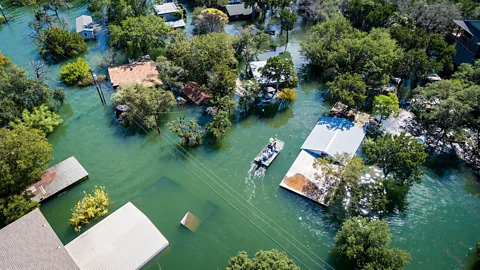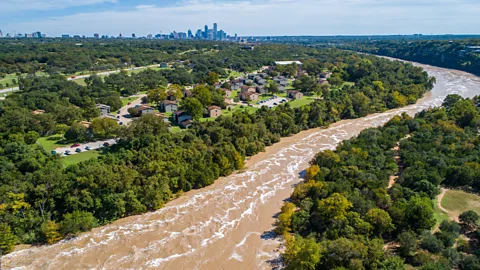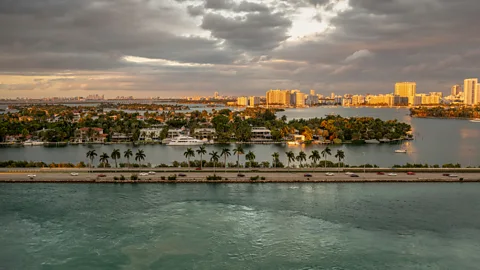Climate change is fuelling the US insurance problem
 Getty Images
Getty ImagesExtreme weather events are making it hard to insure homes in certain parts of the US. What happens when insurance companies simply stop insuring?
When s Acuña received her flood insurance quote for the coming year, she got a shock: it would be increasing from $450 to $1,893 (£355 to £1,490). "I couldn't pay it," she says. "And so now I don't have flood insurance. But I don't feel alone as most of my neighbours don't have flood insurance either."
Acuña, a single mother-of-three, lives in Dove Springs in south-east Austin, Texas, an area that had, until recently, escaped the mass gentrification seen in the rest of the city. That is changing, says Acuña. The astronomical rise in flood insurance, coupled with an affordable housing crisis, is pushing many historic Latino communities out of the area.
In March 2024, Acuña, who is an organiser at Go Austin, a coalition working to improve the health of local communities, will leave the neighbourhood she has lived in for decades. "I bought this house thinking I would die in it," she says, in tears over the decision she has been forced to make. "But I can't afford to live here anymore."
Acuña's insurance went up because of a change in floodplain mapping. In 2018, the National Weather Service updated its flood models to reflect 25 years' worth of flood data. Thousands of houses in Austin that were previously expected to flood only once in every 500 years were upgraded to a risk of one in every 100 years.
 Getty Images
Getty ImagesWith the new data analysis indicating that Austin was at a higher risk of flooding than previously estimated, insurance policies for many homes skyrocketed. In the first half of 2023 alone, s in Texas rose by up to 16%.
Acuña didn't feel the change until she missed a payment at the beginning of 2024 – she had other bills to pay and couldn't spare the money. It meant her policy lapsed, and when she came to renew her policy, she was told about the dramatic increase.
An unfolding crisis
The hike in insurance costs in Austin mirrors a crisis unfolding across America – along both coasts, and through the Midwest. "If you're not worried, you're not paying attention," California Senator Bill Dodd warned in 2023, following the release of a report which found Florida, California and Louisiana would see dramatic rises in home insurance s.
In 2022, insurance firm AllState paused selling new home and condo insurance policies in California. "Our payments to help California residents recover from accidents and disasters have increased significantly in recent years due to higher repair costs and more frequent and severe weather," says a spokesperson for AllState. "We continue to offer coverage to most existing home insurance customers."
In 2023, State Farm, one of the US' biggest insurance providers, announced it too would stop selling new home insurance policies in California. "[We] made this decision due to historic increases in construction costs outpacing inflation, rapidly growing catastrophe exposure, and a challenging reinsurance market," a statement from the company read. It was the latest insurer to pull back from the state, which has been hit by devastating wildfires and floods in recent years, and has the ever-looming threat of a major earthquake. Meanwhile, in Florida, Farmers Insurance discontinued its own-brand home insurance in the state, ing at least a dozen insurers who had already left. "This business decision was necessary to effectively manage risk exposure," a Farmers Insurance spokesperson told the BBC.
The abandonment of these areas is part of a wider story – thanks to climate change, the US is becoming a more volatile place to live. Hurricanes, floods, storms, and fires have caused widespread mass destruction in the US over recent years. It's also becoming more expensive, due to the costs associated with extreme weather events. A report released in 2022 analysed 120 million homes and found one in 10 properties were impacted by natural disasters. Winter storms impacted 12.7 million homes, causing $15bn (£12bn) in property damage in 2021 alone, while hurricanes caused $33bn (£26bn) in damage across 1.2 million homes.
And the future looks even worse. A recent report by First Street Foundation, a non-profit focusing on climate risk research, found 23.9 million properties in the US are at risk from damaging winds, 4.4 million properties at risk from wildfire, and a further 12 million properties have a significant risk of flooding – in addition to properties in the Federal Emergency Management Agency (Fema)'s Special Flood Hazard Areas (100-year flood zones that the government has already identified). "Private insurance companies are effectively labelling areas as uninsurable," the report found.
 Getty Images
Getty ImagesThe home insurance market was valued at $233bn (£184bn) in 2023 It's a business, and if business is bad, insurance companies have no obligation to stick around. Regulations in states such as California, Florida and Louisiana – some of the hardest hit when it comes to climate change impacts – have suppressed insurance prices for years. So, when disaster hits, and insurance companies have to pay out, they can't raise prices the following year to cover their losses. As a result, the insurance industry isn't turning as much profit as it used to, and so the financially sensible thing for them is simply to withdraw from high-risk markets, like California.
State Farm explained its decision to stop accepting new insurance policy applications in California in a press release, citing that the decision was necessary to improve the company's finances.
"It’s necessary to take these actions now to improve the company’s financial strength," a statement from State Farm added.
Who bears the brunt?
The most severe effects from climate change fall disproportionately on socially vulnerable populations, and the US becoming increasingly uninsurable means economically disadvantaged people will bear the burden.
Flooding is the most common and expensive natural disaster in the US, yet fewer than 60% of single-family homeowners living in areas where there's mandatory flood insurance have the insurance.
"A lot of folks who are the most vulnerable, and who are living in the most vulnerable areas, are the ones who tend to have the least financial means," says Steve Bowen, chief science officer at reinsurance broker Gallagher Re. "And so how do you reconcile that">window._taboola = window._taboola || []; _taboola.push({ mode: 'alternating-thumbnails-a', container: 'taboola-below-article', placement: 'Below Article', target_type: 'mix' });
